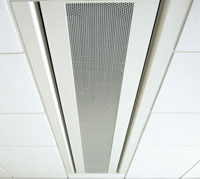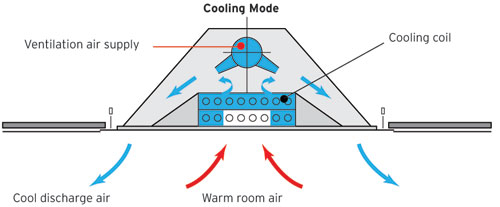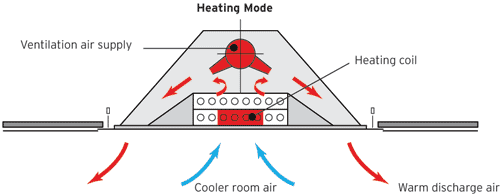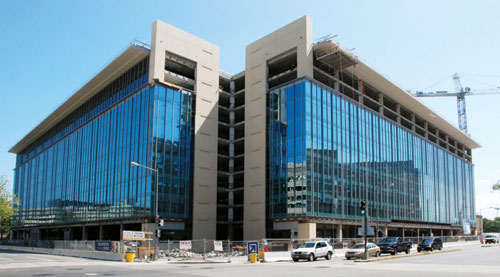An Energy-Conserving Technology From Europe Makes Inroads in the U.S.
Passive versus active
In spaces with higher cooling loads, engineers can choose "active" chilled beams. These are different from their passive cousins, both in mechanical complexity and cooling output. Like passive beams, they depend on natural convection, but they are integrated with the primary ventilation air supply. This centrally conditioned air should be dehumidified, especially in humid climates.
In the operation of active chilled beams, warm room air rises to the ceiling and is drawn into the bottom of the beam by the temperature differential and the inductive effect of the primary air. Inside the beam, the room air is cooled by the coils, mixed with the ventilation air that is introduced at high velocity through nozzles, and discharged into the space through a diffuser. This induction is less noisy than traditional induction units. Active chilled beams require less maintenance than conventional VAV systems because there are fewer moving parts; the coils only need occasional vacuuming. With active beams, the chilled water can be supplied as much as 1.5 degrees below the room's dew point. The continuous airflow reduces the risk of condensation.
Unlike passive beams, active ones combine the cooling mechanism with ventilation air. But in both cases, the need for cooling large volumes of air is eliminated. Higher air velocities give the active beams more cooling potential than passive ones. But because the ventilation air is mixed with the cooled air within the beam before discharging it into the space, the discharge temperature is higher and more uniform than with conventional air-conditioning. Also, according to Haiges, the volume of moving air is 50 to 75 percent lower than with conventional systems. For all these reasons, occupants are less likely to feel drafts.
Optimum spacing of beams throughout a space varies with ceiling height and output capacity. They can be operated singly or grouped for zone control. Although not as silent as passive beams, active chilled beams are quieter than conventional VAV systems. Schultz notes: "Unlike passive beams, active beams can be placed directly over workstations and high convective loads, as these types of beams induce warmer room air up through their center and then disperse the air laterally across the top of the room."
SmithGroup architects and engineers chose active chilled beams for the massive redevelopment of the Constitution Center in Washington, D.C. The 10-story, 1960s-era former Department of Transportation office building was originally designed by Edward Durell Stone. SmithGroup is engaged in a complete overhaul of the entire 1.4-million-square-foot building, which includes replacing Stone's white marble cladding with a glass curtain wall, reinforcing the structure to make it resistant to blasts and progressive collapse, and replacement of mechanical systems.
 |
SmithGroup chose active chilled beams (left) Images courtesy SmithGroup |
|
|
Â
The chilled beams, installed on typical office floors, are expected to realize the benefits of lower energy consumption, greater occupant comfort, and higher ceilings without replacement of the structure. Said to be the largest U.S. installation to date, the chilled beams can be relocated relatively easily, promising future tenant flexibility. SmithGroup's use of chilled beams is part of its bid for a LEED Core and Shell Silver rating. Designers expect that the building, scheduled for completion in late 2009, will use 23 percent less energy than one compliant with the ASHRAE 90.1 standard.
ACTIVE CHILLED BEAMS IN COOLING AND HEATING MODE |
 |
 |
Passive chilled beams cannot be used in heating mode since warm air will not naturally drop from the ceiling into a room. However, active chilled-beam units, which are integrated into the building's primary ventilation air system, can provide either heating or cooling, depending on the temperature of the water supplied to the coil. Image courtesy SmithGroup |
Â
"We looked at all the conventional solutions and kept coming back to chilled beam," says Washington, D.C.−based David Varner, a SmithGroup vice president. Selection of the technology permitted engineers to locate mechanical equipment in a rooftop penthouse rather than on each office floor, allowing more rentable space and a more flexible floor plan, he says. Successful tests with full-size mock-ups convinced the owner the system could work in the muggy Washington summer.










